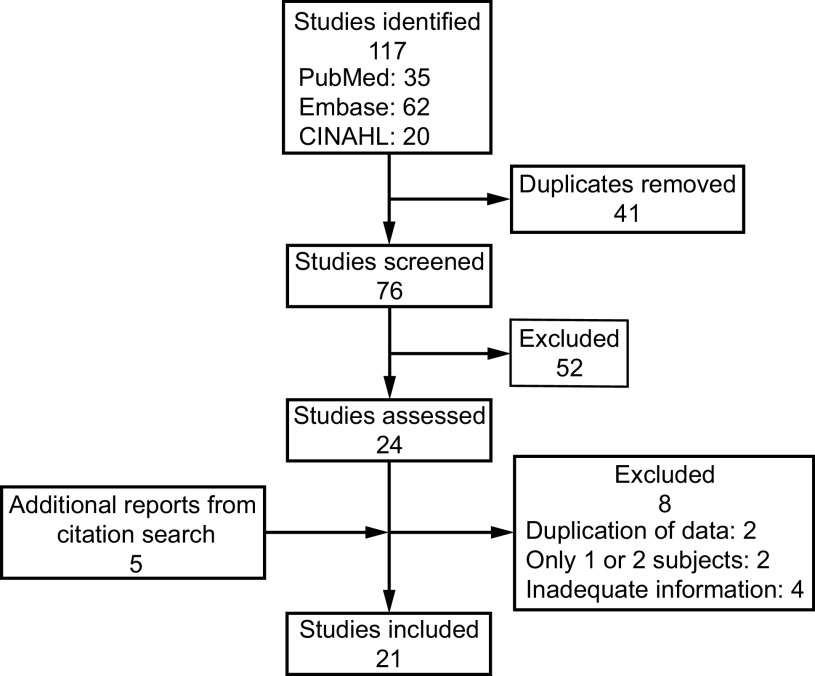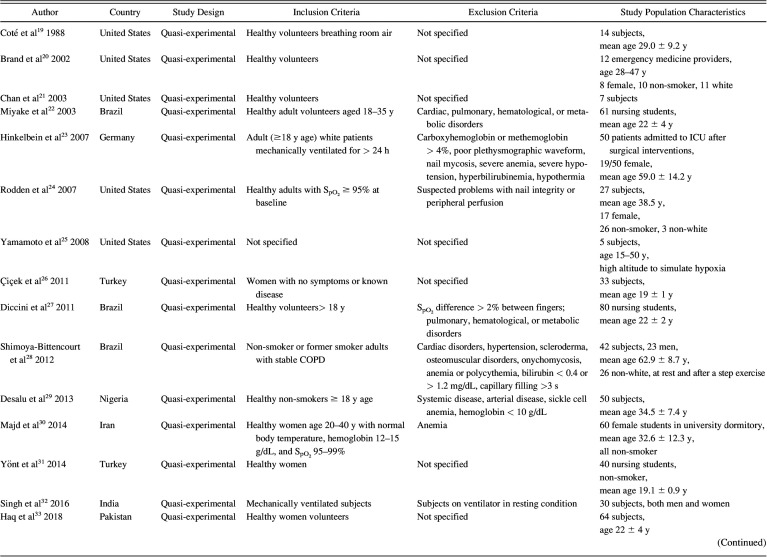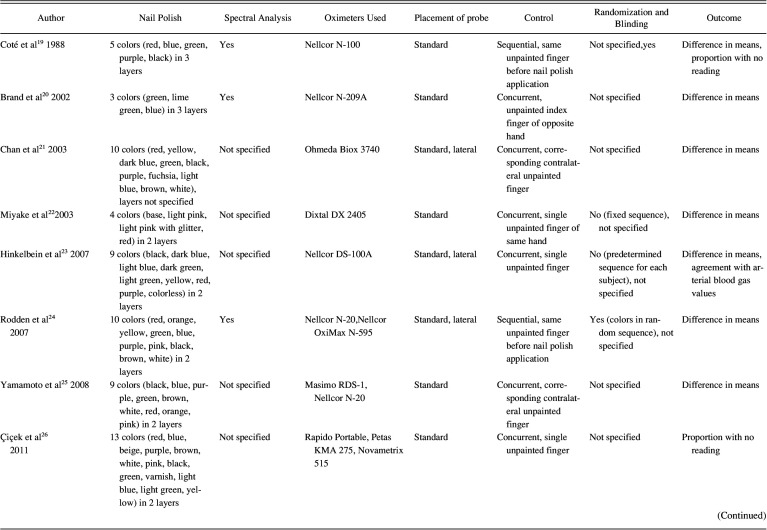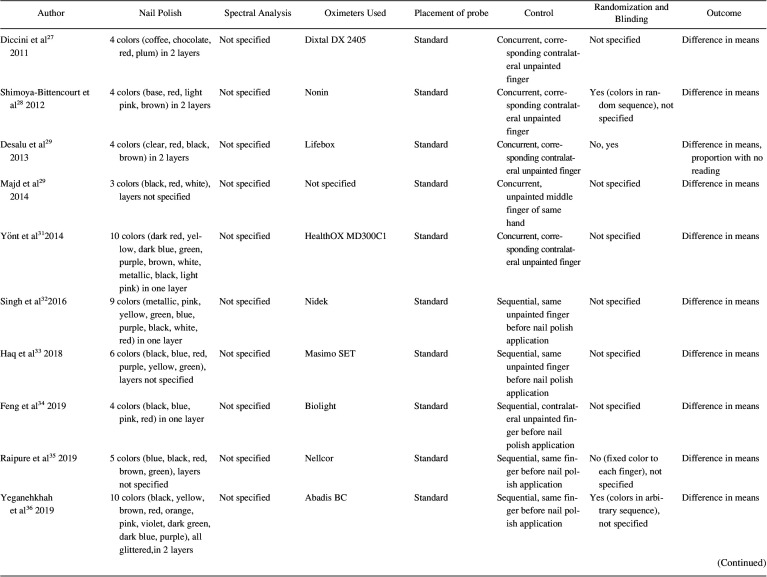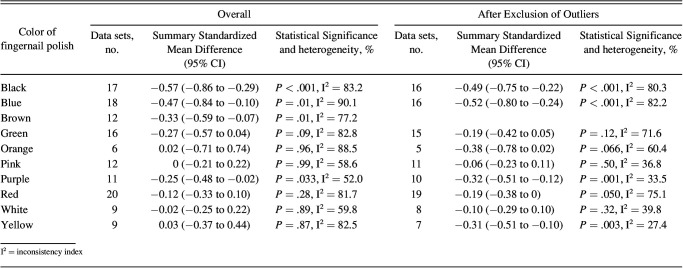Abstract
BACKGROUND:
The effect of application of fingernail polish on SpO2 measurement remains unclear. We conducted this systematic review to ascertain the impact of fingernail polish on SpO2 measurement.
METHODS:
We queried PubMed, Embase, and CINAHL databases for publications indexed through December 2022. We included studies providing paired SpO2 data from fingertips without and after nail polish application or reporting the number of subjects whose SpO2 could not be measured due to fingernail polish. We used random effects modeling to summarize standardized mean differences (SMDs) and corresponding 95% CI for different nail polish colors from comparative studies.
RESULTS:
We retrieved 122 studies and included 21 publications, mostly performed on healthy volunteers. Of these, 17 (81.0%) studies had a low risk of bias. We summarized mean SMD for 10 nail polish colors (black, blue, brown, green, orange, pink, purple, red, white, and yellow) from 25 paired data sets on SpO2 across 20 studies. We found small (likely clinically insignificant) but statistically significant differences in mean SpO2 when fingers were coated with black, blue, brown, or purple nail polish (SMD −0.57, −0.47, −0.33, and −0.25, respectively; 95% CI −0.86 to −0.29, −0.84 to −0.10, −0.59 to −0.07, and −0.48 to −0.02, respectively). Only one of 4 studies reported a high proportion of unsuccessful oximeter readings from fingers painted with black (88.0%) or brown (36.0%) nail polish.
CONCLUSIONS:
Although fingernail polish of some colors can marginally reduce SpO2 reading or occasionally impede SpO2 measurement, the variability is clinically insignificant.
Keywords: color, nail polish, oxygen saturation, pulse oximetry, systematic review
Introduction
Pulse oximetry is a simple noninvasive optical device to ascertain oxygen saturation in the blood using the Beer-Lambert law. Light-emitting diodes (LEDs) in an oximeter generate wavelengths of light in the red and near-infrared spectrum that specifically permit differentiation between oxygenated and deoxygenated hemoglobin in the vascular bed.1,2 Pulse oximeter probes are commonly placed over the fingertips. Technological advancements over time have improved the reliability and portability of these devices. Pulse oximeters are now widely used at home and in health care settings, and SpO2 is considered an important clinical parameter during patient assessment.
The impact of fingernail polish on accuracy of pulse oximetry measurements continues to be a matter of debate. Theoretically, the light absorbed by nail polish pigments during pulse oximetry is constant through the pulse cycles and is, therefore, not an important factor in oxygen saturation estimation, which is largely derived through the pulsatile component of vascular flow. An initial study as early as 1986 noted that fingernail polish application did not significantly influence SpO2.3 Data from subsequent studies showed only a minimal fall in accuracy over a large number of observations, the impact being variable across different colors of fingernail polish.4 This is also consistent with findings from other studies that report minimal effect of vinyl gloves, adhesive tapes, or henna paste application on SpO2 readings.5–7 Despite this evidence, nail polish (especially if dark colored) is still commonly cleaned from patients' fingers before measuring SpO2.8 A few practice guidelines on pulse oximetry also suggest fingernail polish as a potential impediment to measurement accuracy and recommend its removal.9–11 However, nail polish removal requires ready availability of the necessary solvents and time. Since neither may be readily available, especially in an emergent setting, this routine practice could be avoided if there is credible evidence to suggest lack of clinically important effect of fingernail polish on SpO2 readings.
An earlier systematic review summarized information on this topic from 12 publications indexed as of February 2014.12 Although this review found a variable effect of fingernail polish on SpO2 assessment depending on the oximeter used and the color of nail polish, these variations were not considered clinically relevant as they were generally within the ± 2% accuracy range relative to arterial blood gas values permissible for pulse oximeters.1,2 A detailed analysis of the magnitude of error for different nail polish colors was, however, not performed. Also, additional research in this field has been subsequently published. We, therefore, conducted this systematic review to determine the magnitude of change in SpO2 readings with the application of fingernail polish of different colors and to ascertain the rate of unsuccessful measurement of SpO2 due to fingernail polish use.
Methods
We registered our systematic review protocol in the PROSPERO database (registration number CRD42022335582) and report our findings in accordance with the Preferred Reporting Items for Systematic Reviews and Meta-Analyses guidelines.13 Since we utilized only summary information from the articles already published, prior approval from our institutional ethics committee was not required.
We queried the PubMed, Embase, and CINAHL electronic databases on May 31, 2022, using the following free- text search terms: (nail, or fingernail), (polish, color, varnish, glaze, or enamel), and (oximeter, oximetry, or oxygen saturation). We placed no temporal or linguistic restrictions while searching these databases. We further updated our search on December 31, 2022. We also searched bibliographies of the included publications, as well as recent review articles and our personal records, to identify additional studies suitable for analysis.
After excluding duplicate citations, 2 reviewers (ANA and RA) screened all titles and abstracts retrieved through the search process. We disregarded publications not focusing on pulse oximetry or nail polish application. We also excluded editorials, case reports, correspondence not describing original data, review articles, and conference abstracts. Full texts of all studies ascertained as potentially eligible were thereafter independently evaluated in detail by both the reviewers.
We included a study for final data synthesis if it (1) used fingertip pulse oximetry to record paired SpO2 measurements in healthy or diseased subjects, both with and without the application of fingernail polish; and (2) either reported on the mean measured SpO2 values with and without fingernail polish or provided information on the number of subjects whose SpO2 could not be recorded after fingernail polish application. If the same subjects were evaluated in more than one study, only the one describing the largest data set was selected. In the event of any disagreement, consensus between the 2 reviewers determined final study inclusion.
We extracted the following data from the studies finally eligible for inclusion: publication year, country of study, study design, number of subjects, inclusion and exclusion criteria, clinical status of the study subjects (healthy or diseased), the brand and model of pulse oximeters, the colors of nail polish used, number of nail polish coats, blinding, mean and SD of SpO2 with and without the application of fingernail polish, and the number of subjects whose SpO2 could not be determined from fingers coated with nail polish.
We graded the methodological quality of studies using the National Institutes of Health quality assessment tool for before-after (pre-post) studies (https://www.nhlbi.nih.gov/health-topics/study-quality-assessment-tools. Accessed June 2, 2022). Any study with a score ≤ 3 was judged as having a low risk of bias, whereas a study with a score ≥ 9 was considered to have a high risk of bias.
Data on instances where SpO2 could not be determined after fingernail polish coating were expressed as proportions. For studies comparing SpO2 with and without fingernail polish application, we estimated the standardized mean differences (SMDs) and their 95% CI as bias-adjusted Hedges g for paired data.14 SMDs >, or <, zero indicate the degree to which SpO2 measured from painted nails is more, or less, as compared to corresponding SpO2 from unpainted nails. For instance, SMD of −0.5 means that fingernail polish application is associated with a decrease in SpO2 by a mean of 0.5 SD. SMD values of 0.2–0.5, 0.5–0.5, and > 0.8 were considered to represent small, medium, and large effect sizes, respectively.15 The SMD values were considered statistically significant if the corresponding 95% CI did not include zero in its range. Wherever studies reported separate data for more than one oximeter brand/model, we analyzed these measurements independently during data synthesis. We attempted formal pairwise comparisons for different nail polish colors if data were available from 3 or more studies. We constructed forest plots to graphically evaluate the impact of fingernail polish application on SpO2 readings. We calculated the summary effect sizes for SMDs using DerSimonian and Laird random effects model.16
We examined the between-study heterogeneity using Higgins inconsistency index (I2) and judged it high if the I2 value > 0.75.17 We performed sensitivity analysis by excluding any outlier studies, as well as by excluding one study at a time from our analysis to determine if the summary findings were unduly influenced by any single publication. We assessed publication bias using funnel plots and non-parametric rank correlation (Begg) test.18 We used the statistical software Stata (Intercooled edition 12.0, StataCorp, College Station, Texas) for data analysis.
Results
Our literature search yielded 117 citations, and we identified 5 additional studies through other sources (Fig. 1). After removing 41 duplicate citations, we further excluded 6 studies not on pulse oximetry, 11 studies not based on fingernail polish, 9 review articles, 3 editorials, 11 case reports, 3 letters to editor, and 9 conference abstracts on initial screening. We retrieved full-text articles for the remaining 29 studies and finally included 21 publications describing mean SpO2 with and without fingernail polish application (n = 20) or providing information on subjects whose SpO2 could not be measured after fingernail polish application (n = 4).19–39 The major attributes of these 21 studies are summarized in Tables 1 and 2. The reasons for excluding 8 studies after full-text review are outlined in Table S1 of online supplement (See related supplementary materials at http://www.rcjournal.com).
Fig. 1.
Study selection process.
Table 1.
Characteristics of Included Studies
Table 2.
Fingernail Polish Characteristics and Pulse Oximetry in the Included Studies
The study sites were located in different countries (Table 1), more commonly in the United States (n = 5) or Turkey (n = 4). Three (14.3%) articles were published in a language other than English.22,27,34 Most (n = 15, 71.4%) studies were conducted on healthy individuals (Table 1). Four (19.0%) studies evaluated subjects with various respiratory and other disorders.23,28,32,34 Two (9.5%) studies were performed in an ICU setting and one (4.8%) at high-altitude location.23,25,32 One (4.8%) study reported on measurements among pregnant women.35 Six (28.6%) studies specifically reported inclusion of male participants.20,23,24,32,34,36 The included studies evaluated between 3 and 13 colors of fingernail polish (Table 2). Three (14.3%) also performed a spectral analysis for studying absorbance of light of different wavelengths for various nail polish colors.19,20,24 Three (14.3%) studies described measurements separately for more than one oximeter model.24,26,37 Pulse oximetry was performed by placing the oximeter probe laterally across the fingers, in addition to the standard anteroposterior placement in 3 (14.3%) studies.21,23,24 Fingernail polish of different colors was applied in a random sequence in 3 (14.3%) studies.24,28,36 Six (28.6%) studies used a fixed predetermined sequence for various colors, whereas other studies did not provide any information.22,23,29,35,38,39 The SpO2 was recorded concurrently (n = 13) or sequentially (n = 8) from unpainted and painted fingernails (Table 2). Observers recording oxygen saturation were unaware of the nail polish color in only 3 (14.3%) studies.19,29,37 In all, 17 (81.0%) studies had a low risk of bias, whereas the remaining 4 (19.0%) had a moderate risk of bias (Table S2 of online supplement, see related supplementary materials at http://www.rcjournal.com).
The mean SpO2 readings without and after application of different colors of fingernail polish are provided in Table S3 of online supplement (See related supplementary materials at http://www.rcjournal.com). We summarized the SMD data for 10 individual nail polish colors across 25 paired data sets. In all, 17, 18, 12, 16, 6, 12, 11, 20, 9, and 9 such paired data sets provided information on black, blue, brown, green, orange, pink, purple, red, white, and yellow colors of fingernail polish, respectively. These details are provided in the online supplement. There was no publication bias for any of these colors (Fig S1 of online supplement, see related supplementary materials at http://www.rcjournal.com). Information for other colors was not summarized due to small number of studies.
Based on the summary SMD data (and their 95% CI), we found a statistically significant reduction in SpO2 measurements only after application of black, blue, brown, or purple nail polish (Table 3). The highest effect size was for the black color (SMD −0.57 [95% CI −0.86 to −0.29]). This moderate effect size indicates that the SpO2 measured after black fingernail polish application is likely to be lower, relative to the SpO2 obtained from an unpainted finger, by an average of 0.57 SDs. Since the SDs of measured SpO2 were quite small across all studies (Fig S2 of online supplement, see related supplementary materials at http://www.rcjournal.com), hence this summary effect size is placed within the ± 2% accuracy margin generally desirable for pulse oximeters. Even though statistically significant, this difference is, therefore, unlikely to have any significant clinical consequence. By a similar reasoning, the observed differences in SpO2 with other nail polish colors are also unlikely to be clinically important even though some of these differences were statistically significant (Table 3). We repeated these analyses after excluding outlier data sets. Almost all our pooled analyses revealed one or 2 outlier data sets (Figs S2–S11 of online supplement, see related supplementary materials at http://www.rcjournal.com), which were contributed by only 2 studies.19,37 Even after excluding the outlier data, the overall results remained largely similar (Table 3). More details are provided in the online supplement.
Table 3.
Results from pooled analysis of paired measurements (oxygen saturation without and after fingernail polish application)
Four studies reported the proportion of subjects in whom pulse oximetry reading could not be obtained after nail polish application.19,26,29,37 Observers were unaware of nail polish color in 3 of these studies.19,29,37 In 2 studies, more than one oximeter model was tested, and the problem occurred with only some oximeter models.26,37 In particular, use of black or brown nail polish did not permit pulse oximetry in 44 of 50 (88.0%) and 18 of 50 (36.0%) subjects, respectively, in one study.29 Other studies reported failed readings in a lower number of subjects after application of black, blue, brown, green, pink, or purple colored nail polish (Table S3 of online supplement).19,26,37
In addition, one study reported on agreement between oxygen saturation determined by hemato-oximetry and pulse oximetry by calculating the bias (difference) between the 2 measurements among critically ill mechanically ventilated subjects.23 Black, purple, and dark-blue nail polish had the greatest influence on SpO2 recordings (mean bias +1.6, +1.2, and +1.1%, respectively). All other colors had a much smaller effect (mean bias +0.2–+0.9%). Placing the oximeter probe laterally decreased the mean bias from +2.8% to +1.3%. All these errors were considered clinically insignificant and within the manufacturer-specified accuracy range of ± 2% for pulse oximeters. Another study provided information on agreement in SpO2 between painted and unpainted fingers of healthy volunteers using 2 different oximeters.37 The limits of agreement ranged between 3–9% for one oximeter and between 2–17% for the other. Black nail polish showed the maximum variation in readings in both instances.
Three studies also compared oxygen saturation after placing the oximeter probe in the standard anteroposterior position as well as laterally across the fingers.21,23,24 Two studies did not find any difference between the 2 oximeter probe placement configurations.21,24 One study reported some reduction in faulty readings after placing the oximeter probe laterally, but the differences lacked statistical or clinical importance.23
Discussion
We systematically reviewed the impact of fingernail polish application on SpO2 measurements and found statistically significantly lower mean values when fingernails were coated with black, blue, brown, or purple nail polish. The mean SpO2 readings remained similar after applying nail polish of green, orange, pink, red, white, and yellow colors. These differences were, however, small for all 10 shades for which data could be summarized and not clinically important (Table 3). Only one study reported a high proportion of unsuccessful oximeter readings from fingers painted with black or brown nail polish.
There are important clinical implications of our analysis. The largest mean decrease in SpO2 was seen after application of black fingernail polish application, which is likely to be lower by an average of 0.57 SDs relative to the SpO2 obtained from an unpainted finger. The magnitude of decrease was much lower for other nail polish colors. As the SDs of measured SpO2 were quite small in all studies (Fig S2 of online supplement), the absolute mean reduction in SpO2 will be minuscule and most likely clinically insignificant. In general, pulse oximeters are designed to have a much greater accuracy margin of ± 2% for SpO2 measurements, and our projected absolute reduction in mean SpO2 remains well within this boundary. Even though some of our results point to statistically significant reductions in measured SpO2, this difference is unlikely to have any substantial clinical implications across patient groups for all nail polish colors (Table 3). This implies that routine insistence on removing nail polish is unlikely to improve accuracy of SpO2 measurements or to modify clinical management decisions.
Almost all our pooled analyses revealed one or 2 outlier data sets (Figs S2–11 of online supplement), which were contributed by only 2 studies.19,37 One study, using a pulse oximeter with strip-cart recorder, reported far greater SpO2 reductions from fingers painted with black, blue, green, or purple nail polish.19 This could be a technical issue with an older pulse oximeter model or could be related to some nail polish colors chosen based on their spectral attributes. The other, a more recent study, used gel-based nail polish and showed a paradoxical marginal improvement in mean SpO2 readings with some nail polish colors.37 We cannot be certain if this relates to the different physical or chromatic properties of the gel-based nail polish. However, a repeat analysis after excluding these outliers changed the statistical significance in only 2 instances and clinical importance in none (Table 3).
Only 4 studies provided data on subjects where SpO2 could not be recorded due to fingernail polish.19,26,29,37 The proportion of such unsuccessful readings was high for black and brown colors in only one study.29 Two other studies were also responsible for outlier data while summarizing information on mean differences.19,37 It is possible that technical issues, rather than nail polish pigments, led to such problems. Due to the scarcity and heterogeneity of information, it is not possible for us to comment further on the clinical importance (if any) of these data. It has been previously suggested that the oximeter probes can be reoriented laterally across the nails to record SpO2 in such cases, as the SpO2 readings in the 2 positions are virtually identical.40 This was also confirmed in a few studies included in our analysis.21,23,24
Most (81.0%) publications included in our analysis had a low risk of bias. We attempted to deal with potential biases during data acquisition and synthesis. We addressed sampling bias by using a broad search strategy across multiple databases, without any linguistic or temporal restrictions, as well as locating additional publications from other sources. Two reviewers independently assessed studies for eligibility using broad predefined inclusion criteria to handle any selection bias, and data were extracted using standard forms. We formally assessed publication bias for each fingernail polish color and found it to be absent. However, we could not sufficiently address some specific biases arising from the way individual studies were conducted. For instance, only 3 studies applied fingernail polish of different shades in a randomized sequence,24,28,36 and another 3 reported on blinding.19,29,37 We were also unable to assess if there was any systematic error during SpO2 recording due to oximeter characteristics. However, some studies did report variability in the magnitude of differences when 2 or more oximeters were used.26,37
Our analysis has a few limitations. There were several sources of variability among the different studies that we could not adequately address. We analyzed our data by different groups of nail polish colors. Broadly, blue and green nail polishes absorb more light at 660 nm than at 940 nm and could theoretically interfere more with SpO2 measurement.19,20 However, different nail polish brands use different pigments to produce a large array of shades within any single color category, each of which could potentially exhibit a distinctive light absorption spectrum. Several pulse oximeter models with varying optical attributes, LED intensities, and sensor technologies were used in these studies. It is possible that newer pulse oximeters with brighter light and better detectors may circumvent problems related to the constant absorption of a fraction of emitted light by the nail polish pigments. There were also variations in thickness of nail polish coats. Moreover, all investigators applied fresh coats of nail polish for their studies, and it is not clear if the SpO2 alterations remain similar even after a few days. Most studies conducted experiments on young and apparently healthy volunteers expected to have normal baseline SpO2. Hence, it is difficult to extrapolate our results to other age groups or to people with different health statuses. In particular, most SpO2 measurements from unpainted fingertips were in the normal range even for subjects with respiratory disease or those who were critically ill and on life support. Finally, we are uncertain if our observations hold valid for hypoxemic patients, where even small variations could prove clinically meaningful due to the sigmoidal shape of oxygen dissociation curve.
Conclusions
The application of fingernail polish can marginally reduce SpO2 reading in groups of patients, and in very few people, it may not be possible to measure SpO2 from the painted nails. Black, blue, and brown nail polish are associated with the maximum mean reduction in SpO2, but even these do not appear to be clinically important. Based on our analysis, we do not recommend routine removal of fingernail polish prior to pulse oximetry. In the unlikely event of failure to record SpO2 over painted fingers, the reading can be attempted after repositioning the oximeter probe laterally across the nails before contemplating removal of fingernail polish. More evidence is needed from hypoxemic patients using fingernail polish to confirm the clinical importance of our observations.
Footnotes
The authors have disclosed no conflicts of interest.
Supplementary material related to this paper is available at http://www.rcjournal.com.
REFERENCES
- 1. Hanning CD, Alexander-Williams JM. Pulse oximetry: a practical review. BMJ 1995;311(7001):367–370. [DOI] [PMC free article] [PubMed] [Google Scholar]
- 2. Nitzan M, Romem A, Koppel R. Pulse oximetry: fundamentals and technology update. Med Devices (Auckl) 2014;7:231–239. [DOI] [PMC free article] [PubMed] [Google Scholar]
- 3. Kataria BK, Lampkins R. Nail polish does not affect pulse oximeter saturation. Anesth Analg 1986;65(7):824. [DOI] [PubMed] [Google Scholar]
- 4. Ralston AC, Webb RK, Runciman WB. Potential errors in pulse oximetry. III: Effects of interferences, dyes, dyshemoglobins and other pigments. Anaesthesia 1991;46(4):291–295. [DOI] [PubMed] [Google Scholar]
- 5. Ackerman WE, Juneja MM, Baumann RC, Kaczorowski DM. The use of a vinyl glove does not affect pulse oximeter monitoring. Anesthesiology 1989;70(3):558–559. [DOI] [PubMed] [Google Scholar]
- 6. Read MS. Effect of transparent adhesive tape on pulse oximetry. Anesth Analg 1989;68(5):701–702. [PubMed] [Google Scholar]
- 7. Al-Majed SA, Harakati MS. The effect of henna paste on oxygen saturation reading obtained by pulse oximetry. Trop Geogr Med 1994;46(1):38–39. [PubMed] [Google Scholar]
- 8. Bucx MJL, Krijtenburg P. Perioperative management of nail polish, artificial nails, and piercings in the Netherlands. Eur J Anaesthesiol 2016;33(3):223–224. [DOI] [PubMed] [Google Scholar]
- 9. American Association for Respiratory Care. AARC clinical practice guideline. Pulse oximetry. Respir Care 1991;36(12):1406–1409. [PubMed] [Google Scholar]
- 10. Pretto JJ, Roebuck T, Beckert L, Hamilton G. Clinical use of pulse oximetry: official guidelines from the Thoracic Society of Australia and New Zealand. Respirology 2014;19(1):38–46. [DOI] [PubMed] [Google Scholar]
- 11. Luks AM, Swenson ER. Pulse oximetry for monitoring patients with COVID-19 at home. Potential pitfalls and practical guidance. Annals ATS 2020;17(9):1040–1046. [DOI] [PMC free article] [PubMed] [Google Scholar]
- 12. Ballesteros-Peña S, Fernández-Aedo I, Picón A, Lorrio-Palomino S. Influence of nail polish on pulse oximeter readings of oxygen saturation: a systematic review. Emergencias 2015;27(5):325–331. [PubMed] [Google Scholar]
- 13. Page MJ, Moher D, Bossuyt PM, Boutron I, Hoffmann TC, Mulrow CD, et al. PRISMA 2020 explanation and elaboration: updated guidance and exemplars for reporting systematic reviews. BMJ 2021;372:n160. [DOI] [PMC free article] [PubMed] [Google Scholar]
- 14. Hedges LV. Distribution theory for Glass's estimator of effect size and related estimators. J Educ Stat 1981;6(2):107–128. [Google Scholar]
- 15. Cohen J. Statistical power analysis for the behavioral sciences, 2nd edition. Hillsdale, N.J: Lawrence Erlbaum; 1988: 9–74. [Google Scholar]
- 16. DerSimonian R, Laird N. Meta-analysis in clinical trials. Control Clin Trials 1986;7(3):177–188. [DOI] [PubMed] [Google Scholar]
- 17. Higgins JP, Thompson SG, Deeks JJ, Altman DG. Measuring inconsistency in meta-analyses. BMJ 2003;327(7414):557–560. [DOI] [PMC free article] [PubMed] [Google Scholar]
- 18. Begg CB, Mazumdar M. Operating characteristics of a rank correlation test for publication bias. Biometrics 1994;50(4):1088–1101. [PubMed] [Google Scholar]
- 19. Coté CJ, Goldstein EA, Fuchsman WH, Hoaglin DC. The effect of nail polish on pulse oximetry. Anesth Analg 1988;67(7):683–686. [PubMed] [Google Scholar]
- 20. Brand TM, Brand ME, Jay GD. Enamel nail polish does not interfere with pulse oximetry among normoxic volunteers. J Clin Monit Comput 2002;17(2):93–96. [DOI] [PubMed] [Google Scholar]
- 21. Chan MM, Chan MM, Chan ED. What is the effect of fingernail polish on pulse oximetry? Chest 2003;123(6):2163–2164. [DOI] [PubMed] [Google Scholar]
- 22. Miyake MH, Diccini S, Bettencourt ARC. Interference of nail polish colors and time on pulse oximetry in healthy volunteers. J. Pneumologia 2003;29(6):386–390. [Google Scholar]
- 23. Hinkelbein J, Genzwuerker HV, Sogl R, Fiedler F. Effect of nail polish on oxygen saturation determined by pulse oximetry in critically ill patients. Resuscitation 2007;72(1):82–91. [DOI] [PubMed] [Google Scholar]
- 24. Rodden AM, Spicer L, Diaz VA, Steyer TE. Does fingernail polish affect pulse oximeter readings? Intensive Crit Care Nurs 2007;23(1):51–55. [DOI] [PubMed] [Google Scholar]
- 25. Yamamoto LG, Yamamoto JA, Yamamoto JB, Yamamoto BE, Yamamoto PP. Nail polish does not significantly affect pulse oximetry measurements in mildly hypoxic subjects. Respir Care 2008;53(11):1470–1474. [PubMed] [Google Scholar]
- 26. Çiçek HS, Gümüs S, Deniz Ö, Yildiz S, Açikel CH, Çakir E, et al. Effect of nail polish and henna on oxygen saturation determined by pulse oximetry in healthy young adult females. Emerg Med J 2011;28(9):783–785. [DOI] [PubMed] [Google Scholar]
- 27. Diccini S, Pereira EM, Im SY, Shida LY, Bettencourt ARC. Evaluation of pulse oximetry measurements in healthy subjects with nail polish. Acta Paulista de Enfermagem 2011;24(6):784–788. [Google Scholar]
- 28. Shimoya-Bittencourt W, Pereira CA, Diccini S, Bettencourt AR. Interference of nail polish on the peripheral oxygen saturation in patients with lung problems during exercise. Rev Lat Am Enfermagem 2012;20(6):1169–1175. [DOI] [PubMed] [Google Scholar]
- 29. Desalu I, Diakparomre OI, Salami AO, Abiola AO. The effect of nail polish and acrylic nails on pulse oximetry reading using the Lifebox oximeter in Nigeria. Niger Postgrad Med J 2013;20(4):331–335. [PubMed] [Google Scholar]
- 30. Majd PM, Zolfaghari M, Aeen FB, Mohseni A, Azimi K, Haghani H. The comparison between the impacts of henna and nail polish on pulse oximetry among healthy women. Nursing Practice Today 2014;1(3):120–125. [Google Scholar]
- 31. Yönt GH, Korhan EA, Dizer B. The effect of nail polish on pulse oximetry readings. Intensive Crit Care Nurs 2014;30(2):111–115. [DOI] [PubMed] [Google Scholar]
- 32. Singh VP, Ayub S. Effect of different colors of nail polish on pulse oximeter's readings in ventilated patients. Int Res J Eng Technol 2016;3(9):1359–1361. [Google Scholar]
- 33. Haq A, Zafar K, Fatima M, Shafique M. Effects of different nail polish colors on arterial blood oxygen saturation values (SpO2) in Pakistani population. In: Proceedings of the 2018 3rd International Conference on Biomedical Imaging, Signal Processing. Bari, Italy: Association for Computing Machinery; 2018:6–9. [Google Scholar]
- 34. Feng J, Wang C, Bai H. Influence of different colors of nail polish on pulse oximeter readings in patients with modified electroconvulsive therapy. Chin J Integr Nurs 2019;5(7):97–99. [Google Scholar]
- 35. Raipure A, Ankalwar V, Tirpude NG, Gaikawad K. Effect of nail paint on pulse oximetry values and clinical importance. J Med Sci Clin Res 2019;7(9):261–265. [Google Scholar]
- 36. Yeganehkhah M, Dadkhahtehrani T, Bagheri A, Kachoie A. Effect of glittered nail polish on pulse oximetry measurements in healthy subjects. Iran J Nurs Midwifery Res 2019;24(1):25–29. [DOI] [PMC free article] [PubMed] [Google Scholar]
- 37. Yek JLJ, Abdullah HR, Goh JPS, Chan YW. The effects of gel-based manicure on pulse oximetry. Singapore Med J 2019;60(8):432–435. [DOI] [PMC free article] [PubMed] [Google Scholar]
- 38. Yikar SK, Arslan S, Nazik E. The effect of nail polish on pulse oximeter's measurements in healthy individuals. Int J Caring Sci 2019;12(2):1144–1147. [Google Scholar]
- 39. Doğan SD, Yikar SK, Arslan S, Nazik E. The effect of nail polish and henna on the measures of pulse oximeters in healthy persons. J Perianesth Nurs 2021;36(5):532–535. [DOI] [PubMed] [Google Scholar]
- 40. White PF, Boyle WA. Nail polish and oximetry. Anesth Analg 1989;68(4):546–547. [PubMed] [Google Scholar]



